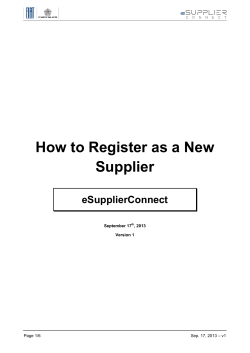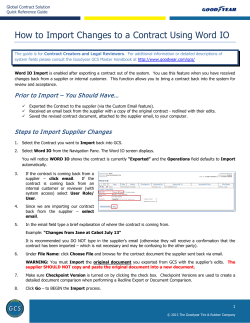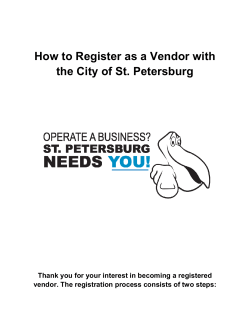
Building Exit Barriers Through Value Management:
Building Exit Barriers Through Value Management: Examining the Relationships between Perceived Switching Costs and Customer Value Annie H. Liu and Mark P. Leach Loyola Marymount University Submitted to the 19th Annual IMP Conference For Competitive Paper April 30, 2003 Address all correspondence to: Dr. Annie H. Liu Department of Marketing Loyola Marymount University 1 LMU Dr. Los Angeles, CA 90045 Phone: (310) 338-3039 Fax: (310) 338-3000 email: aliu@lmu.edu Building Exit Barriers Through Value Management: Examining the Relationships between Perceived Switching Costs and Customer Value How can business service suppliers build exit barriers without “hard assets” such as transaction specific investments? What strategic actions should service suppliers pursue in order to lock in their buyers for the long haul? The current study suggests that through strategic customer value management, service suppliers are able to mentally create high costs associated with switching, and hence, establish exit barriers for their customers. Through an extensive literature review, qualitative interviews, and an empirical investigation, the current study examines three dimensions of customer value and their relationships to switching costs. The findings show that value from relational / support services and economic value exert strong positive impact on customers’ perceptions of switching costs. However, the result does not provide sufficient support for the relationship between value of core / technical service and switching costs. Actionable strategies are discussed to simultaneously manage various aspects of value in order to build exit barriers. Building Exit Barriers Through Value Management: Examining the Relationships between Perceived Switching Costs and Customer Value Companies have traditionally focused their customer retention efforts on enhancing customer satisfaction or providing high levels of customer value. Theoretically, satisfaction building activities should convert current customers into long-term loyal customers. However, recent empirical studies suggest that satisfaction tends to have short-term or current effect on retention (Reichheld 1996). To help solidify longer-term working relationships, business suppliers may also attempt to strategically retain buyers by simultaneously managing value perceptions and building exit barriers. Traditionally, marketers have conceptualized the idea of “switching costs” and “exit barriers” primarily as “hard assets” such as installed proprietary equipment, software programs, etc. These transaction specific investments (TSIs) prevent buyers from easily switching to and from competitors. However, particularly when looking at providers of business services, providers often lack these transaction specific hard assets and consequently, explore other aspects of their business relationships with their customers to establish switching costs. In exchange relationships where hard assets are uncommon (e.g., service provider – customer relations, wholesaler – customer relations), it is often “soft assets” such as relational or procedural business support that build perceived switching costs. Switching costs based on procedures and personal relations, although non-monetary, can mentally prevent buyers from searching for attractive alternatives and from jumping ship (Burnham, Frels, and Mahajan 2003). Therefore, identifying strategic actions that may result in customer perceptions of high switching costs is paramount. Research in the areas of customer value / service value suggests that superior value maybe an effective predictor of strong customer loyalty, repeat business, and switching behavior (Anderson and Narus 1998; Grisaffe and Kumar 1998). Reichheld (1996) argues that it is the value that customers feel they receive, rather than their level of satisfaction that keep them returning. As a result, several researchers suggest that customer value may be an important predictor of switching behavior. However, value has repeatedly been conceptualized as being multi-dimensional and little is known regarding how various aspects of customer value impact a customer’s perception of switching costs. The purpose of this study is to examine the concept of customer value and its role in building switching costs perceptions of customers purchasing business services. The primary objectives of this research include: (1) to develop scales and empirically validate a typology of customer value for business services, and (2) to assess the predictive effects of various dimensions of customer value on buyers’ switching costs perceptions. LITERATURE REVIEW AND HYPOTHSIS DEVELOPMENT Customer Value Literature Review Past research in marketing on the concept of value can be categorized into three areas: (1) research on consumer consumption value; (2) research on perceived value; and (3) research on customer value or relative value. These areas are briefly reviewed to illustrate previous conceptualizations of customer value and to demonstrate how value in a business exchange may be best represented as an organizational buyer’s perceived tradeoff comparison among benefits received, costs paid, relative to competitive alternatives. Consumer Consumption Value. Hirschman and Holbrook (1982) proposed that a customer’s post-purchase consumption experience includes the experiential consumption value (i.e., symbolic, hedonic, and aesthetic nature of consumption), as well as rational consumption value (i.e., problem solving and need satisfaction). They defined experiential consumption value, or customer value (Holbrook 1994), as “an interactive, relativistic, preference experience” (p. 27) and advocated that consumers’ fantasies, feelings and fun need to be integrated with the rational consumption value that most consumer information processing frameworks account for. Later, Holbrook (1994) constructed a taxonomic scheme of eight types of customer value (e.g., efficiency, quality, play). Although the taxonomy of consumption value was developed for consumer markets and focused on emotional vs. rational aspects of consumption, Holbrook's research suggests that value is multi faceted and can be derived from varied sources. Thus, the investigation of customer value for business services should begin by identifying relevant sources of value and underlying dimensions of value. Perceived Value. Research on perceived value often examines the relationships among perceived quality, and price (e.g., Zeithaml 1988). Perceived value is often viewed as a consumer’s overall assessment of what is received and what is given (Zeithaml 1988; p14), and as a tradeoff between perceived quality and its affordability within a choice setting (Monroe and Krishnan 1985; p. 210). Zeithaml suggests that all costs that are salient to customers, such as monetary price and non-monetary price (e.g., time and effort) should be incorporated as perceived costs, and that the benefit components of perceived value should include perceived quality, and other intrinsic and extrinsic attributes. In general, this stream of literature suggests that value is a tradeoff between quality and price and that value enhances repurchase intention and discourages switching behavior (Wathne, Biong, and Heide 2001) Customer Value. Expanding on the idea that value consists of a mental comparison or tradeoff between benefits and costs, recent studies focus attention on the importance of competitive alternatives (e.g., Ulaga and Chacour 2001; Anderson and Narus 1998; Grisaffe and Kumar 1998). Naumann (1995) suggests that as competitive alternatives increase, customers may come to expect more value from a purchase. Likewise, when many substitutes are available, overall value perceptions of a current offer are likely to decrease. Empirical studies have begun to demonstrate customer’s perceptions of an offer relative to competitors’ through customer value maps (i.e., plots of relative quality and relative price; Sinha and DeSaro 1998; Gale 1994). The concept of relative value has been investigated and found to have more influence on customers’ intention to recommend suppliers than does absolute value. As such, the availability of competition, whether as a reference or a substitute, exerts a strong influence on customer value perceptions. Together with an internal benefits and costs tradeoff, the availability of competition provides external comparison and should be integrated in creating customer value construct. Definition of Customer Value Anderson and Thomson (1997) define value in business markets as “the perceived worth in monetary terms of the economic, technical, service, and social benefits received by a customer firm in exchange for the price paid for a product offering, taking into consideration competing suppliers’ offering and prices.” (p. 2). Customer value is often viewed as quality adjusted for price compare to competitive alternatives (Gale 1994). As such, we define customer value as an organizational buyer’s assessment of the economical, technical, and relational benefits received, in exchange for the price paid for a supplier’s offer relative to competitive alternatives. Types of Customer Value To better understand various types or dimensions of customer value that business buyers perceive, we thoroughly reviewed the literature and conducted interviews with industry managers and business buyers. We then followed scale development procedures prescribed by Anderson and Gerbing (1988), and James, Mulaik and Brett (1982) and found support for three distinct types of customer value. 1. Economic value refers to an organizational buyer’s overall benefits / costs assessment of a supplier relative to alternative suppliers. Here, the benefit component is mainly associated with service quality and the cost component includes price or the monetary terms of a service offer. Thus, the economic value construct emphasizes the overall price/quality comparison taking into account competitors. Similar to the concept “incentive to purchase” (Anderson and Narus 1998) and “acquisition value” (Unbany, Bearden, Kaicker and Smith-De Borrero 1997), a customer’s assessment of economic value compares a supplier’s offer to competitive alternatives. 2. Value of the relational /support service pertains to how customers asses the benefits and effectiveness of the working relationships with one supplier relative to alternative suppliers. Relational value is the “interpersonal aspects of a relationship” and is usually derived from social bonds between business buyers and suppliers (Wilson, Soni, and O’Keeffe 1995). To enhance relational value, suppliers often identify functions that are important to buyers and engage in activities to meet their specifications. Simultaneously, through communications and specifications, buyers often invest resources (e. g., time and personnel) to achieve customized services. If and when buyers and suppliers, through effective way of doing business, develop interpersonal relationships, the value of relational /support service will be cemented. 3. Value of the technical / core service refers to the technical performance of a supplier relative to alternative suppliers. Similar to the performance factor proposed by Sinha and DeSarbo (1998), core service value includes professional, technical, and procedural performances. Because most business services are implemented individually by technical consultants or service personnel, they are often more difficult to standardize than tangible products. As such, core service value may vary depending on the service provider. One way that most business service suppliers enhance core service value is through periodic buyer evaluations to impart an objective view of the technical performance. These three dimensions of service value represent the essence of many business services, and therefore, will be evaluated independently to strategically identify the critical impact of each on switching costs and exit barriers. Perceived Switching Costs Literature Review Perceived switching costs are defined here as industrial buyers’ perception of the costs associated with terminating a current supplier and establishing a new relationship with the replacement supplier. The process involved in evaluating the costs associated with switching should include an assessment of past investments as well as the perceived potential adjustment costs in establishing a new relationship with the replacement (Burnham, Frels, and Mahajan 2003). Heide and John (1988) suggest that idiosyncratic investments that cannot be easily transferred to other service providers can increase exchange partners’ switching costs. From the industrial buyers’ perspective, the established personal relationships, along with familiar procedures, and knowledge of contact persons which are present with a current supplier, may be viewed as perceived switching costs and, hence, create a significant barrier to change suppliers. In addition, because developing a new relationship with another service provider not only requires sacrificing of past investments, but also requires modifications of the established routines, Jackson (1985) maintains that industrial buyers are often motivated to stay in existing relationships to economize on switching costs. As such, perceived switching costs can be viewed as exit barriers that hold customers in relationships (Jones, Mothersbaugh, and Beatty 2002). Perceived switching costs indicate the ease or difficulty an organizational buyer has in replacing an existing supplier. From an organizational buyer’s perspective, the replaceability of a supplier decreases dependency on that supplier, and therefore, allows alternative choice decisions. Empirical studies show that high perceived switching costs will decrease organizational search effort, and will limit a customer’s consideration process (Heide and Weiss 1995). Additionally, perceived switching costs are found to increase future interactions, commitment (Heide and John 1990; Anderson and Weitz 1992), and decrease exit intention (Ping 1994). The concept of economic value focuses on high quality and / or low price compared to alternatives. Wathne, Biong and Heide (2001) suggest that price is the most critical determinant to switching behavior and consequently, is the strongest exit barrier. In other words, as buyers perceive that they are getting a better deal (higher quality or lower price compared to competitors), they will perceive the costs associated with switching from this suppliers as being higher. H1 is as follows: H1: Organizational buyers’ perceptions of a supplier’s economic value have a positive effect on their perceptions of switching costs. Relational / Support value is generally co-created by both buyer’s and supplier’s personnel working closely together, investing time, effort, and resources to identify and develop mutual specifications. Through mutual investments, specifications, and adaptations, buyer and supplier are likely to establish interpersonal aspects to their relationship, or social bonds (Wilson et al 1995). Therefore, successful working relationships are likely to establish a network identify that is difficult to replace, hence, increase exit barriers. H2 is as follows: H2: Organizational buyers’ perceptions of a supplier’s relational/support value have a positive effect on their perceptions of switching costs. Core services that are performed by competent service personnel tend to increase buyer’s dependency on the provider and, consequently, raise buyer’s perception of costs associated with switching. Familiar procedures and established routines performed by adept personnel may create a comfort zone for buyers and thus, build a significant barrier to change suppliers. H3 states: H3: Organizational buyers’ perceptions of a supplier’s core service value have a positive effect on their perceptions of switching costs. METHOD AND RESULTS In-depth interviews were conducted with business service customers and suppliers to better understand industry and market dynamics. Based on the insights of the personal interviews, a database was compiled from the survey responses of business customers purchasing from business service firms in the financial staffing industry. A sample of two hundred and six firms (response rate = 24%) was analyzed regarding buyer perceptions of values and switching costs. All scales were multi-item, and items were seven-point Likert scaled; anchored by “strongly disagree” (1) and “strongly agree” (7). Structural Equation Modeling techniques were used to construct a measurement model, to model the structural relationships, and to calculate the relative weights of the relationship between perceived switching costs and customer perceptions of economic value, relational value and core value. The four-factor unrestricted model was estimated using 16 items: four items each measuring economic value, relational value, core value, and perceived switching costs. Scale means, standard deviations, and the correlations among the latent constructs appear in Table 1. A chisquare difference statistic indicated that the four-factor unrestricted model was statistically better fitting than the three-factor model, and did not fit statistically worse than a five-factor model. Next, the result of overall fit statistics of the measurement model using confirmatory factor analysis indicated good fit (χ2 = 234.73, 98 d.f., CFI = 0.95, GFI = 0.88, TLI = 0.94, RMSEA = 0.08). In addition, all items were found to load strongly on the intended latent construct. The scale reliability for the economic value, relational value, core value, and perceived switching costs constructs were .88, .85, .97, and .82 respectively (see Table 2). Then, constraints of the theoretical model were imposed. Structural parameters were allowed to vary freely or were fixed to zero in order to impose the hypothesized pattern of relationships in the proposed model. The results of the structural model showed that the proposed structural model fit well with the data (χ2 = 234.73, 98 d.f., CFI = 0.95, GFI = 0.88, TLI = 0.94, RMSEA =0 .08). Two hypothesized parameters were found to be significant and positive (see Figure 1). First, value of the relational / support service was shown to have a strong positive impact on perceived switching costs (H2; γ = .33, z = 2.40). In addition, economic value was found to affect switching costs positively (H1; γ = .33, z = 2.08). As such, the findings indicate that the perceptions of relational value through relationship bonding and economic value through comparisons of quality and price are important in building exit barriers for business services. However, the result didn’t provide evidence of a relationship between value of the technical / core service and switching costs perceptions (H3; γ = - .13, z = -1.17, ns). DISCUSSION AND MANAGERIAL IMPLICATIONS Wathne, Biong and Heide (2001) suggest that value / price is the most critical determinant of switching behavior; customers may switch when competitors offer higher value. However, when customers perceive that switching costs are high, they may attempt to renegotiate terms, instead of switching when competitive offers are present (Sirdeshmukh, Singh and Sabol 2000). This study sheds some light on how supplier firms can enhance switching costs, and consequently, raise exit barriers, by better managing various aspects of customer value perceptions. Specifically, the current study suggests that for suppliers attempting to lock in their customers for the long haul, introducing relationship-oriented behaviors and practices may be an effective strategy to manage value perceptions in the competitive market. Qualitative interviews revealed that relational behaviors such as visiting customers when needed, informing customers of new developments, and being knowledgeable about customers’ business are ways to enhance relational value perceptions. Perceived switching costs that develop from perceptions of high relational value are not likely to diminish since these costs are associated with losing personal relationships, learning costs, and set up costs (Burnham et al. 2003). In line with previous research (Wathane et al 2001), economic value, emphasizing price and quality comparison, exerts strong positive influence on switching costs. Although price alone cannot build a long-term competitive advantage, high value offered by an incumbent firm may create perceptions of high switching costs, hence, deter a customer’s exit. It is the higher quality or lower price relative to competitors that helps suppliers create an “incentive to purchase”. Customers who received services with high economic value are less likely to search for or evaluate other alternatives; therefore, their exit potential is lower. Often time, customers who received high economic value are also hesitant to switch due to potential loss of accumulated benefits or discounts (Guiltinan 1989). In all, the current study shows that to build exit barriers, a supplier should combat competitive offers by establishing stronger relational support with its customers, and by providing higher economic value to discourage searching and exiting. Although in this study value of the core / technical service does not seem to impact customer’s perceptions of switching costs, core value maybe a “hygiene” factor that may promote customers’ switching if not properly managed. In industries or businesses where technical performance is quite uniform, value of the core service may not provide an exit barrier, but the importance of maintaining and managing core value should not be de-emphasized. As such, simultaneously building and delivering various aspects of customer value and integrating value perception management in strategic decision will aid suppliers in building exit barriers. REFERENCES Anderson, Erin and Barton Weitz (1992), “The Use of Pledges to Build and Sustain Commitment in Distribution Channels,” Journal of Marketing Research, 29 (February),18-34. Anderson, James C. and David W. Gerbing (1988), “Structural Equation Modeling in Practice: A Review and Recommended Two Step Approach,” Psychological Bulletin, 103, 411-23. ________ and James Narus A. (1998), “Business Marketing: Understand What Customers Value,” Harvard Business Review (November-December), 53-65. Anderson, James C. and James B. L. Thomson (1997), “Combining Value and Price to Make Purchase Decisions in Business Models,” ISBM Report # 3-1997, Institute for the Study of Business Markets, The Pennsylvania State University. Burnham, Thomas A. Judy K. Frels, and Vijay Mahajan (2003), “Consumer Switching Costs: A Typology, Antecedents, and Consequences,” Journal of academy of Marketing Science, 31 (2), 109-26. Gale, Bradley (1994), Managing Customer Value: Creating Quality and Service That Customers Can See, New York, NY: The Free Press. Grisaffe, Douglas B. and Anand Kumar (1998), “Antecedents and Consequences of Customer Value: Testing an Expanded Framework,” MSI Working Paper Report No. 98-107, Marketing Science Institute, Cambridge, MA. Guiltinan, Joseph P. (1989), “A Classification of Switching Costs with Implications for Relationship Marketing,” in 1989 AMA Winter Educators’ Conference: Marketing Theory and Practice. Eds. Terry L. Childers, Richard P. Bagozzi, and J. Paul Peter. Chicago: American Marketing Association, 216-20. Heide, Jan B. and George John (1990), “Alliances in Industrial Purchasing: The Determinants of Joint Action in Buyer-Supplier Relationships,” Journal of Marketing Research, 27 (February), 2436. _______ and _______ (1988), “The Role of Dependence Balancing in Safeguarding TransactionSpecific Assets in Conventional Channels,” Journal of Marketing, 52 (January), 20-35. _____ and Allen M. Weiss (1995), “Vendor Consideration and Switching Behavior for Buyers in High-Technology Markets,” Journal of Marketing, 59 (July), 30-43. Hirschman, Elizabeth, C. and Morris B. Holbrook (1982), “Hedonic Consumption: Emerging Concepts, Methods and Propositions,” Journal of Marketing, 46, 92-101 Holbrook, Morris B. (1994), “The Nature of Customer Value: An Axiology of Services in the Consumption Experience,” in Service Quality: New Directions in Theory and Practice, Roland T. Rust, and Richard L. Oliver, eds. Thousand Oaks, CA: Sage Publications, 21-71. Jackson, Barbara Bund (1985), “Build Customer Relationships that Last,” Harvard Business Review, 63(November-December), 120-128. James, Lawrence R., Stanley A. Mulaik, and Jeane M. Brett (1982), Causal Analysis: Assumptions, Models, and Data. Beverly Hills, CA: Sage Publications. Jones, Michael A. David L. Mothersbaugh and Sharon E. Beatty (2002), “Why Customers Stay: Measuring the Underlying Dimensions of Services Switching Costs and Managing Their Differential Strategic Outcomes,” Journal of Business Research, 55 (6), 441-50. Liu, Annie H., Mark P., Leach and Kenneth L. Bernhardt (1999), “Examining Customer Value, Satisfaction, and Switching Costs in Multiple-Sourcing Purchase Decisions for Business Services,” Institute for the Study of Business Markets Report 6-1999, University Park: Pennsylvania. Monroe, Kent B. and R. Krishnan (1985), “The Effect of Price on Subjective Product Evaluations,” In Perceived Quality, Jacob Jacoby and Jerry Olson, eds. Lexington, MA: Lexington Books, 209-32. Naumann, Earl (1995), Creating Customer Value: The Path to Sustainable Competitive Advantage, Cincinnati, OH: Thomson Executive Press. Ping, Robert A. (1994), “Does Satisfaction Moderate the Association between Alternative Attractiveness and Exit Intention in a Marketing Channel?” Journal of Academy of Marketing Science, 22 (Fall), 364-371. Reichheld, Frederick F. (1996), “Learning from Customer Defections,” Harvard Business Review, March-April, 56-69. Sinha, Indrajit, and Wayne S. DeSarbo, (1998), “An Integrated Approach Toward the Spatial Modeling of Perceived Customer Value,” Journal of Marketing Research, 35 (May), 236-49. Sirdeshmukh, Deepak, Jagdip Singh and Barry Sabol (2002), “Consumer Trust, Value, and Loyalty in Relational Exchanges,” Journal of Marketing; 66 (1), 15-37. Ulaga, Wolfgang and Chacour Samir. Measuring Customer-Perceived Value in Business Markets: A Prerequisite for Marketing Strategy Development and Implementation. Industrial Marketing Management 2001; 30 (August): 525-540. Urbany, Joel E., William O. Bearden, Ajit Kaicker, and Melinda Smith-De Borrero (1997), “Transaction Utility Effects When Quality is Uncertain,” Journal of the Academy of Marketing Science, 25(1), 45-55. Wathne, Kenneth H., Harald Hiong and Jan B. Heide (2001), “Choice of Supplier in Embedded Markets: Relationship and Marketing Program Effects,” Journal of Marketing, 65 (2), 54-66. Zeithaml, Valarie A. (1988), “ Consumer Perceptions of Price, Quality, and Value: A Means-End Model and Synthesis of Evidence,” Journal of Marketing, 52 (July), 2-22. Table 1 Scale Means, Standard Deviations, and Correlations among Latent Constructs 1 2 3 4 Value of a Supplier’s Core Service Value of a Supplier’s Relational Service Economic Value of a Supplier Perceived Switching Costs Mean 4.94 4.94 5.06 3.00 Std. 1.11 1.06 1.24 1.43 1 2 .68 .74 .81 .27 .45 3 .41 Table 2 Scale Reliabilities and Measurement Items Z-value Standard Estimate α** Constructs Value of a Supplier’s Core Service Compared to other suppliers, this supplier’s service providers … VC1. … are more competent. VC2. … are more professional. VC3. … have better overall job performance. VC4. … have better attitudes on the job.* 0.97 18.09 18.11 17.56 0.96 0.96 0.94 Value of a Supplier’s Support Service Compared to other suppliers, this supplier’s account manager … VS1. … has a better working relationships with us. VS2. … responds to our service needs more promptly. VS3. … visits our location when needed. VS4. … keeps us better informed of new developments. Economic Value of a Supplier Compared to other suppliers, this supplier … VE1. … provides the best value. VE2. … provides better value for the money. VE3. … provides low quality for the price. (r) VE4. … charges a reasonable price for the services provided.* 0.85 15.76 16.25 11.72 8.37 0.90 0.91 0.74 0.57 0.88 15.63 14.44 11.93 0.90 0.85 0.75 Perceived Switching Costs C1. If we decide to stop working with this supplier, it would be time consuming to relearn new procedures with another supplier. C2. Developing working relationships with other suppliers would be a time-consuming process. C3. Developing procedures to deal effectively with another supplier’s account manager would take a lot of time and effort. C4. Our relationship with this supplier is irreplaceable.* * ** (r) 0.82 10.02 0.68 12.78 0.83 13.10 0.84 Items eliminated through re-specification of the confirmatory factor analysis measurement model. Chronbach alpha is provided for the final scale and does not include the eliminated items. Reverse coded items. Figure 1 Summary of Findings Chi-Square = 234.73, Degrees of Freedom = 98 CFI = .95, GFI = .88, TLI = .94, RMSEA = .08 Economic Value d1 .33 .79 .73 Support Value .33 -.13 (ns) .68 Core Value Perceived Switching Costs
© Copyright 2025











